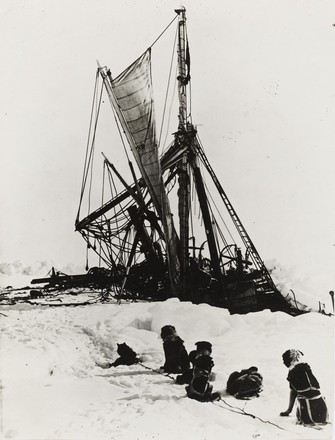Following
a sense of adventure or patriotism, or simply the call of friendship, many
people who had experience in Antarctic exploration volunteered to serve in the
armies of World War 1. Traces of many of these men, the records they leave in
maps, diaries, photographs, printed materials and ephemera are preserved in the
State Library of New South Wales. They
are a reminder of the contribution they made to our understanding of the world.
In the worst case, they are a reminder of their sacrifice and of an untimely
end to a life of potential and contribution.
Companions
in the south, the paths of these men sometimes crossed in the trenches of the
European war. Here, Australian photographer Frank Hurley met sledging companions
Leslie Russell Blake and Eric Webb. A few years before, during their expedition
towards the South Magnetic Pole, these friends nearly died in the harsh and
dangerous conditions on the Antarctic plateau. Later, while on leave in London,
Hurley met both Douglas Mawson and Ernest Shackleton.
The
living conditions on the front often reminded men like Hurley of his
experiences in the south. Only a short time after his extraordinary time lost
on the bitter Antarctic Elephant Island and living for 4 1/2 months with 21
others under upturned lifeboats, Hurley wrote in his war diaries about the
warmth of companionship. In his diary, he commented on his response to the
carnage while walking through battlefields strewn with dismembered corpses:
The Menin road is like
passing through the Valley of Death, for one never knows when a shell will lob
in front of him. It is the most gruesome shambles I have ever seen, with the
exception of the South Georgia whaling stations, but here it is terrible as the
dead things are men and horses. [17 September 1917]
On
30 December 1917, Hurley was with members of the Australian Light Horse in
Palestine. That evening the men made camp, settling and feeding the
horses. As the dark grew around them,
the soldiers gathered around a fire and asked Hurley to tell them about
Antarctica. In this extraordinary moment the connections between the
experiences of the explorers of the then almost completely unknown southern
continent and the experiences of people in World War 1 became apparent. He wrote about the episode:
After dinner the boys invited me to their
campfire, and asked me to give them a few words about my Antarctic experiences.
The novelty of the surroundings impressed me greatly, and I felt, in the
interest expressed on the faces around me a reward for the tribulations of the
South… How all these, my fellow countrymen appreciated my story. How they
sympathized with the hardships and how they joined in hilarity when I related…
the primitive routine of daily life. I enjoyed it as much as they.
He
completed his entry with a reflection that the companionship of these men
reminded him of that of the Antarctic teams, sleeping in cramped and dangerous
circumstances: ‘tightly packed, but warm and contented’



 Back to list
Back to list